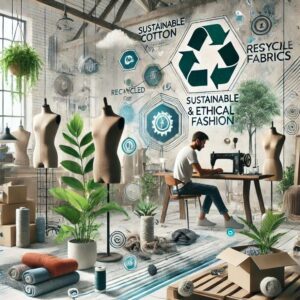
🌿 Eco-Friendly Materials: The New Foundation of the Industrial Revolution
Today, I present to you a unique and comprehensive piece on eco-friendly materials, a pioneering work being written for the first time in the world. This text will show you how eco-friendly materials are transforming product design, manufacturing, and consumer habits across multiple global industries. If you like this content, please let us know, and if you require further details on any specific topic, you can contact us.
Eco-friendly materials have initiated a revolutionary transformation in the fundamental infrastructure of global industries. These materials are not only environmentally safe but also significantly reduce pressure on natural resources during their production and use. Various types of eco-friendly materials include biodegradable plastics, natural fibers, recycled metals, and sustainable wood.
Biodegradable plastics are typically derived from plant-based sources such as corn, sugarcane, or seaweed and decompose naturally in a much shorter time compared to conventional plastics. Natural fibers like jute, bamboo, and hemp are not only sustainable but also require fewer chemical fertilizers and pesticides during cultivation. The use of recycled metals, especially aluminum and steel, not only reduces the negative environmental impacts of mining but also cuts energy consumption by 50 to 70 percent.
Sustainable wood is sourced by adhering to strict forest conservation principles set by organizations like the FSC (Forest Stewardship Council) and PEFC (Programme for the Endorsement of Forest Certification). Another important category of eco-friendly materials is bio-composites, which are produced by combining natural fibers with bioplastics and possess strength comparable to traditional composite materials. The production of all these materials follows the principles of green chemistry, aiming to minimize the use of hazardous chemical substances.
The use of eco-friendly materials not only reduces the environmental impact of products but also makes waste management easier at the end of their life cycle. These materials promote the concept of a circular economy, where products and materials can be continuously reused instead of being discarded. All these characteristics make eco-friendly materials an ideal alternative for the current industrial system.
🎨 Revolutionary Changes in Product Design
Eco-friendly materials have fundamentally transformed traditional concepts of product design. Designers now adhere to the “Cradle to Cradle” concept during product creation, meaning products are designed so that their materials can be reused at the end of their life cycle. Under this design philosophy, products are made to be easily disassembled, facilitating repair, upgrading, and recycling processes.
Designers now follow “Design for Disassembly” principles, where products are designed so that their various parts can be easily separated. Additionally, “Design for Durability” involves designing products to last for a long time, helping to reduce waste. The use of eco-friendly materials has given designers new creative freedom, resulting in unique and beautiful products.
For example, products made from bioplastics can incorporate properties like transparency and flexibility, which were not possible with traditional plastics. Products made from natural fibers are not only eco-friendly but also possess natural beauty and uniqueness. Designers are now also using eco-friendly materials for product packaging, including fungus-based packaging, paper foam, and biodegradable plastic films. The use of eco-friendly materials in product design is not only yielding environmental benefits but also enhancing product performance and durability.
🏭 New Manufacturing Methods and Processes
Eco-friendly materials have also brought significant changes to manufacturing methods and processes. Industrial enterprises are now adopting green technologies in their manufacturing processes, leading not only to reduced energy consumption but also a significant decrease in waste production.
The use of Additive Manufacturing or 3D printing can reduce material waste by 70 to 90 percent, as this method uses only the necessary material. Bio-based Manufacturing uses biological materials as raw materials, reducing carbon emissions during the manufacturing process. Closed-loop Manufacturing Systems allow industrial waste to be reused, reducing the need for new raw materials.
Manufacturing processes based on green chemistry principles avoid the use of hazardous chemicals, benefiting both the environment and worker health. Modern water management systems can reduce water usage in manufacturing processes by up to 50 percent. The use of renewable energy sources like solar and wind power is decreasing reliance on fossil fuels during manufacturing.
Smart Manufacturing Systems enable the monitoring and control of manufacturing processes, increasing efficiency and reducing waste. New machinery and equipment are being developed for manufacturing eco-friendly materials, which are not only more efficient but also consume less energy. All these changes are collectively making the manufacturing industry more sustainable and environmentally friendly.
🛒 Changes in Consumer Habits and Behavior
Eco-friendly materials have also created significant changes in consumer habits and behavior. Today’s consumers, when making purchasing decisions, consider not only price and quality but also the environmental impact of products. According to a recent survey, over 70% of consumers prefer products that are eco-friendly and are willing to buy from companies that undertake environmental protection initiatives.
The trend of “Green Consumerism” is rapidly growing among consumers, where they choose products with minimal environmental impact. Consumers now look for eco-labels on product packaging, which provide information about the product’s environmental effects. The concept of the “Sharing Economy” has also changed consumer habits, where consumers prefer using products rather than owning them.
Under the “Circular Economy,” consumers are promoting product repair, reuse, and recycling. Environmental awareness among consumers is increasing through digital platforms, where they can exchange information about the environmental impact of products. These changes in consumer behavior have compelled industries to incorporate environmental protection measures into their products and processes.
As a result, industrial organizations are becoming more transparent about their environmental impacts and providing information about their products’ environmental performance.
🌍 Impacts on Global Industries
The use of eco-friendly materials has had profound effects on various global industries. In the fashion industry, the use of eco-friendly materials has given birth to a new movement known as “Sustainable Fashion.” Under this movement, fashion designers and manufacturers are using Eco-friendly materials like jute, bamboo, and recycled fibers.
In the construction industry, the use of Eco-friendly materials has promoted the concept of “Green Building,” which utilises recycled steel, sustainable wood, and energy-saving materials. In the automotive industry, the use of eco-friendly materials is reducing vehicle weight, improving their fuel efficiency.
In the electronics industry, the use of Eco-friendly materials is helping to address the problem of e-waste. In the food and beverage industry, the use of biodegradable packaging materials is helping to reduce plastic waste. In the aerospace industry, the use of lightweight and strong Eco-friendly materials is improving fuel efficiency.
In the medical industry, the use of bio-compatible Eco-friendly materials is enabling the production of safe and effective medical devices for patients. In the packaging industry, the use of Eco-friendly materials has promoted the concept of “Green Packaging.” In all these industries, the use of Eco-friendly materials is not only reducing environmental impacts but also yielding economic benefits.
💼 Economic Benefits and Business Opportunities
The use of Eco-friendly materials has opened new doors for economic benefits and business opportunities. For businesses, using Eco-friendly materials not only reduces operational costs but also provides access to new markets.
The production and use of Eco-friendly materials are creating new employment opportunities in fields such as environmental design, green chemistry, and sustainability expertise. Businesses can reduce their carbon footprint by manufacturing Eco-friendly products, helping them avoid carbon taxes and other environmental penalties.
The use of Eco-friendly materials allows businesses to enter international markets, as many countries prioritise the import of Eco-friendly products. Implementing circular economy models can help businesses reduce waste management costs and generate additional revenue from recycled materials.
Investment in the research and development of Eco-friendly materials fosters the development of new technologies and processes. Businesses can enhance their brand value and gain customer loyalty by producing Eco-friendly products. Using Eco-friendly materials makes it easier for businesses to obtain green financing from banks and financial institutions. All these economic benefits combined make the use of Eco-friendly materials a smart investment for businesses.
🔬 Research & Development and Future Trends
Research and development in the field of Eco-friendly materials has opened new possibilities. Research institutions worldwide are working on new types of Eco-friendly materials and novel methods for their production. The use of nanotechnology is enhancing the performance and durability of Eco-friendly materials.
Through biotechnology, new types of bio-based materials are being developed that are not only Eco-friendly but also perform equal to or better than traditional materials. The use of Artificial Intelligence and Machine Learning is improving the design and production processes of Eco-friendly materials.
Researchers are working on self-healing Eco-friendly materials, which could extend product lifespans. The development of sustainable adhesives and coatings is improving product performance and durability. Researchers are working on Eco-friendly materials that can capture carbon dioxide, potentially helping to mitigate the effects of climate change.
The development of smart materials could lead to products that can adapt to their environment. Increased use of Eco-friendly materials is expected in the future, further reducing the environmental impact of industries. As a result of R&D, the cost of Eco-friendly materials is decreasing, making their use more widespread.
🌱 Role in Achieving Environmental Protection and Sustainability
The use of Eco-friendly materials plays a crucial role in achieving environmental protection and sustainability. Their use helps conserve natural resources, as they are typically produced using renewable resources. The use of Eco-friendly materials reduces waste generation, as these materials are generally biodegradable or easily recyclable.
Their production process consumes less energy, reducing greenhouse gas emissions. The use of Eco-friendly materials reduces water pollution, as their production involves fewer toxic chemicals. These materials are proving beneficial for the protection of terrestrial and aquatic life, as their waste causes minimal harm to the environment.
The use of Eco-friendly materials is helping to solve problems associated with municipal and industrial waste management. These materials can help mitigate the effects of climate change. The use of Eco-friendly materials can play a significant role in achieving the United Nations’ Sustainable Development Goals.
Given all these benefits, the use of Eco-friendly materials has become a vital tool for achieving environmental protection and sustainability.


